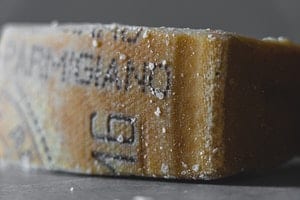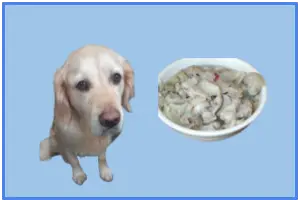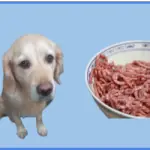
Do you often feel a pang of guilt when you’re making dinner for the family and your trusted dog just sits there with a sad and resigned look in his eyes?
He knows he’s not getting any of the yummy food you’re making.
While it is true that a human diet is not exactly suitable for dogs, there are some foods you can safely give your pet and, yes, some types of cheese can be a great addition to his diet.
Let’s have a look at the health benefits of cheese and how you can use it to make even picky eaters gulp down their chow.
What you will learn from this article
- Why is cheese good for your dog
- Can I sprinkle Parmesan cheese on your dog’s food?
- Parmesan vs Cheddar: How are they different?
- What about other cheeses?
- What are the top reasons that dogs are picky eaters?
- Best ways to make picky eaters eat?
- Most healthy foods to sprinkle on dog food
- The benefits of raw food for your dog
- Why is Parmesan cheese good for dogs?
- Why is Parmesan cheese bad for dogs?
- Is Parmesan healthier than Cheddar cheese?
- Grated or block of Parmesan cheese?
- Why does my dog only eat his food with Parmesan cheese?
- Final thoughts
Why is cheese good for your dog
Cheese is a staple food for many peoples around the world and, if you consider the Mediteranean diet which relies heavily on this it looks like it is quite healthy, at least for us humans. But it can benefit dogs as well.
Cheese is produced from fermented milk and processed in different ways to account for the many varieties on the market. Cheese is an excellent source of protein, fats, vitamin A, vitamin B12, as well as calcium and other minerals like phosphorus and zinc.
We need all these and so do dogs. If you think about your pet’s ancestors, the wolf, it’s obvious that dogs were meant to have a diet rich in protein and fats that come from meat, but there are plenty of those in cheese as well.
Calcium is essential for bone health, especially for breeds that are more vulnerable to osteoporosis.
What you should be wary of is the salt (or sodium) content in cheese. Sodium is necessary up to a point, but too much of it leads to high blood pressure, which is a problem for both you and your furry friend. Elevated blood pressure can lead to major organ damage in dogs.
Another ingredient in cheese that might cause problems to your dog is lactose, as his digestive system cannot handle large quantities of it. That is why milk is not recommended for dogs.
Can I sprinkle Parmesan cheese on your dog’s food?
As a rule, adding a bit of cheese to your dog’s regular food is a good idea as it provides valuable nutrients, but as mentioned above not all cheeses are created equal.
Parmesan, made with the original Italian recipe, is quite salty and therefore not the best option for your dog.
Just a sprinkle once in a long while won’t hurt your fur baby, but regular consumption will.
Let’s just look at the sodium content in Parmesan, that’s 1529 mg of sodium per 100 g of cheese. That’s quite a lot. There are some varieties of low-sodium Parmesan on the market, but that’s not the original recipe.
Parmesan vs Cheddar: How are they different?
If you would like to sprinkle some cheese on your dog’s meal you should perhaps try Cheddar, which has a lower sodium content, 612 mg per 100 grams of cheese. Cheddar has less calories and a lower content of calcium and protein, but that should not be a problem if you feed your dog an adequate diet.
What about other cheeses?
Blue cheeses aren’t healthy for your dog either because of the high sodium content.
The best option for your dog as far as cheeses are concerned is cottage cheese, which is less salty. Traditional Italian Mozzarella is also less salty. Another good treat for your dog is soft goat cheese. However, you should keep in mind that soft cheeses have a high lactose content, compared to hard cheese. If your dog has a sensitive stomach, offer him just a small quantity of soft cheese and what his stools.
What are the top reasons that dogs are picky eaters?
Many dog owners have this problem – their beloved pet turns his head in disgust when presented with his meal, although it’s healthy and balanced, at least according to the label.
Some experts believe it is mostly the pet parent’s fault because the dog gets too much choice and he is constantly offered the latest delicacies on the market. Well, be that as it may, but you cannot accuse an animal lover of trying to make their fur baby happy!
Another reason that also has to do with pampering your pet is that the dog is smart enough to know that if he begs hard enough he will be getting some yummylicious treats from the dinner table. Again, what can you do when the dog is practically staring at your mouth?
At the same time, no matter how nutritious or super-balanced regular dog food is, would you eat that every day? Yes, a dog can survive solely on kibble but why should he when he knows there are plenty of options?
Basically, it’s the same problem many people have with their children and the above mentioned experts believe you should be firm with your dog. If the dog refuses to eat, let him starve for a couple of days and then he’ll eat. Just as most people don’t have the heart to take this approach with kids, pet owners won’t let their dog go hungry no matter what the experts say.
Best ways to make picky eaters eat?
If your dog is on a commercial food diet, wet or dry, try to determine which brand or flavour he prefers and stick with that.
When your dog starts refusing to eat his kibble, a good idea is to try and add wet food on top of it. Canned food is more watery and easier to it, it has more flavor and the gravy makes it more palatable.
However, if your pet still won’t eat the best you can do is supplement his regular meal with human food. There are many types of food you can add to his food that are both tasty and healthy.
Another option is to change your dog’s diet altogether and switch to raw food. More on that below.
Most healthy foods to sprinkle on dog food
A little grated hard cheese or some cottage cheese mixed in with the dog’s normal food might do the trick and make him gobble everything in his bowl, but you cannot rely solely on that because too much of it might cause problems to your dog.
Raw eggs are a quick and inexpensive food you can safely add to your pet’s meal. They’re rich in protein and fatty acids and are a great source of iron and vitamins. If you could also put the egg shells through the coffee grinder and sprinkle them on top of his food that would supplement his diet with much needed calcium.
Pumpkin puree is rich in fiber and does wonder for your dog’s digestion. It is often recommended as a go-to food when your pet has diarrhea, but you can use pumpkin any time.
Bone or chicken broth can also help make your dog’s food more appealing, only make sure to serve him some before adding salt to it.
Sardines are very healthy as they have a lot of Omega-3 fatty acids so you can mix a few with your dog’s meal. Just a few, to see if he likes the taste or not.
Vegetables, preferably fresh, never hurt anyone and your dog might appreciate a bit of variety in his life. Try blending the vegetables first so they’re easy to mix in.
The benefits of raw food for your dog
Pet owners who keep their dogs on a raw food diet rarely complain about their companion being a picky eater. No matter what dog food commercials tell you your pet, big or small, is a wolf at heart and always will be. Pet food, wet or dry, has become so popular because it is convenient for the owner, especially kibble which doesn’t spoil easily and a big bag can last you a month. Nobody ever asked the dogs if they’re happy with processed food.
Raw food, starting with a nice juicy bone with some lean muscle meat still hanging on it, is irresistible to any dog. And it does provide a naturally balanced nutrition, with the right amount of protein and fat. First and foremost, your dog needs animal protein, not the corn and wheat they stuff in processed food.
A dog on a raw diet has regular bowel movements, smaller and of the less smelly kind. At the same time, raw food makes your dog’s coat shinier and you will notice your pet is full of energy, maybe too much of it…
Raw food also helps keep your dog’s teeth clean in a natural way so you won’t have to put your pet through the ordeal of tooth-brushing. Or yourself, for that matter.
Obviously, you won’t feed your dog bones all the time. You should regularly give your dog animal organs, like liver and kidneys, raw eggs, and add as many vegetables as possible. Fiber matters! The best vegetables for a healthy dog are broccoli, spinach and celery. And don’t forget the occasional fruit, like apples.
Why is Parmesan cheese good for dogs?
Now this might be a bit of a stretch to discuss the health benefits of Parmesan cheese but it does have some good points.
For instance, 36% of the cheese is protein which is a great nutrient for your dog to have. Protein helps to repair and build new cells within their body.
But more subtle benefits from Parmesan come from the tiny amounts of very important minerals and vitamins that it contains.
The one which steals the headlines is calcium- which is great when it comes to strong bones and teeth.
But this cheese also contains quite a lot of vitamin A- which helps to maintain a dog’s eyes.
Large amounts of Vitamin B2 and B12 are also present in Parmesan and B vitamins play an important role in many processes- one of them being helping to convert food into energy.
Anyway, enough about the benefits of this cheese.
In the next section, I want to get more real.
Why is Parmesan cheese bad for dogs?
I think that this is a much easier section to write than the previous section!
Used too frequently or used in too large quantities then Parmesan cheese won’t help your dog.
To start with I want to talk about the amount of salt in this cheese.
Too much salt might increase your dog’s blood pressure and the more salt that dog’s consume, the more water they will need to drink.
Other unhealthy aspects of this cheese include the fat and cholesterol.
This cheese is 25% fat.
Dogs need fat in their diet, but too much fat, as we all know, can lead to an increased risk of obesity.
Which leads on to another question which I will answer in the next section.
Is Parmesan healthier than Cheddar cheese?
After doing a little research for this question, I’m quite surprised by the answer.
Which is that Parmesan is the healthier option for your dog.
If you discount the salt content in it, Parmesan is lower in fat and cholesterol than cheddar cheese
Here is a comparison table below.
| 100g serving | Parmesan | Cheddar |
| Calories | 392 | 408 |
| Fat | 25 g | 34 g |
| Cholesterol | 68 mg | 100 mg |
| Sodium | 1175 mg | 654 mg |
| Protein | 36 g | 23 g |
Grated or block of Parmesan cheese?
A question that is sometimes asked is what type of Parmesan cheese your dog should eat.
It’s a popular cheese and is available as a solid block or comes grated.
Now grated cheese is great for those of us in a rush because it saves us a few minutes when it comes to preparing our dog’s food and it involves less clearing up than grating a block of Parmesan cheese yourself.
But here’s the thing.
Many grated Parmesan cheeses have a few chemicals added in order to make sure that the cheese stays grated in the packet and doesn’t disintegrate.
At the very least these chemicals include cellulose powder and potassium sorbate.
At their worst, these grated editions contain wood pulp.
If I were you, when it comes to buying Parmesan for you or your dog I would continue to buy it in blocks!
Why does my dog only eat his food with Parmesan cheese?
The final question that I want to look at is aimed at those of you who have a dog that will only eat their real dog food if it contains a bit of Parmesan.
Now, apart from the dangers to your dog’s health from feeding your dog Parmesan everyday, there is a financial danger to your wallet or purse.
This is expensive cheese!
The reason that your dog only eats food when it is mixed with expensive Italian cheese is because they can!
I’m sorry if I have burst a bubble for those of you who were thinking that your dog had some ancient Italian ancestry which has moulded their taste buds.
But the issue isn’t about genes or DNA but it is about behaviour.
And if you want to stop it then you need to be mentally stronger than your dog (don’t cave into those sad looks) and if necessary let them miss a few meals.
They won’t starve, I promise!
Final thoughts
Dogs need and deserve some variety with their food. This does not mean table scraps, as only few of the things we, humans, eat are healthy for dogs. Adding a bit of cheese to a dog’s meal is a great way to make a picky eater eat and provides valuable nutrients. However, moderation is key, as most cheeses are too full of sodium for them. Stick with soft low-sodium cheese and go easy on hard cheese, like Parmesan. A light sprinkle every now and then won’t hurt, but there are other options you should explore, starting with eggs, vegetables and even raw food.





